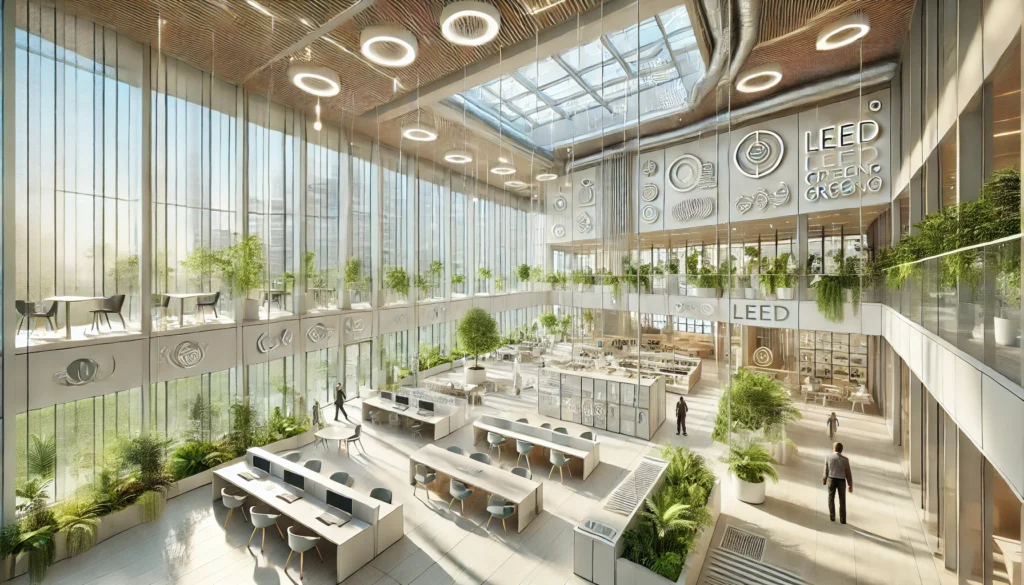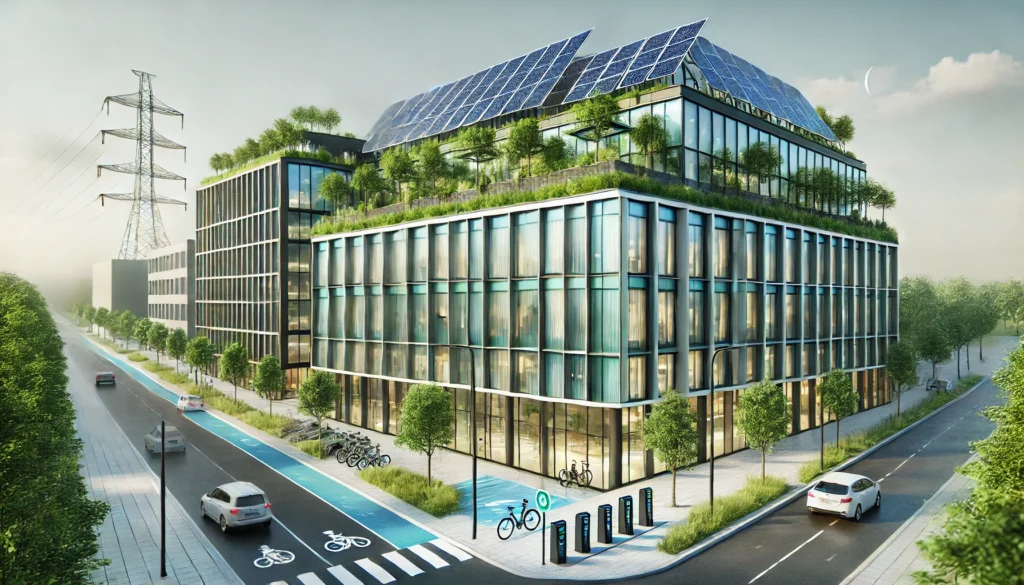Sustainability is more than just a buzzword in today’s world; it’s a crucial standard that drives the construction and real estate industries. As businesses, homeowners, and institutions increasingly prioritize environmental stewardship, achieving certifications like LEED (Leadership in Energy and Environmental Design) has become a mark of distinction and responsibility. Whether you’re a building owner, developer, or architect, understanding LEED certification can not only help you contribute to environmental sustainability but also improve building efficiency, reduce costs, and attract eco-conscious tenants.
In this guide, we will dive deep into everything you need to know about LEED certification, from its benefits and levels to the certification process itself.
What is LEED Certification?
LEED Certification is a globally recognized green building certification system developed by the U.S. Green Building Council (USGBC). It provides a framework for designing, constructing, and operating high-performance green buildings that prioritize environmental responsibility, resource efficiency, and occupant well-being.
Quick Facts:
- Developed by: U.S. Green Building Council (USGBC)
- Launched in: 1998
- Focus: Sustainable buildings, water efficiency, energy optimization, material reuse, and improved air quality.
- Applicable to: Commercial buildings, residential buildings, schools, healthcare facilities, and neighborhoods.
LEED certification covers the entire lifecycle of a building from the design phase through construction and operations. The certification is based on a points system, where buildings accumulate credits for sustainable practices and design features.
History and Purpose of LEED
LEED was introduced in 1998 by the USGBC to address the increasing demand for sustainable building practices. The goal was to standardize green construction, making it easier for developers, architects, and building owners to embrace sustainability. It also aims to reduce the environmental impact of buildings, which, according to studies, account for about 39% of global CO2 emissions.
LEED’s Main Objectives:
- Reduce energy use and carbon footprints.
- Conserve water.
- Promote sustainable building materials.
- Improve indoor air quality.
- Encourage smart urban development.
LEED is continuously evolving. Its most recent iteration, LEED v4.1, was introduced in 2019, making the certification system more accessible and aligned with modern sustainability goals.
Key LEED Certification Categories
LEED certification is categorized into specific areas of environmental impact. Each category addresses a particular aspect of building sustainability and earns points based on performance in those areas.
1. Location and Transportation
This category assesses the building’s proximity to public transportation, sustainable commuting options, and the overall impact of the location on the environment.
2. Sustainable Sites
This section evaluates how the construction of the building impacts the environment surrounding the site, including land protection, management of rainwater, and minimization of soil erosion.
3. Water Efficiency
Buildings are encouraged to use less water through innovative plumbing solutions, landscaping techniques, and water-efficient appliances.
4. Energy and Atmosphere
A building’s energy performance is crucial. This category promotes the use of renewable energy sources, energy-efficient heating and cooling systems, and overall energy performance optimization.
5. Materials and Resources
This category assesses the materials used in construction, promoting reuse, recycling, and sourcing sustainable materials.
6. Indoor Environmental Quality
This ensures that the air quality inside the building is safe and healthy for its occupants, promoting better ventilation, less pollution, and occupant comfort.
7. Innovation
Projects can earn additional points for innovative design and construction that go beyond the established LEED criteria.
LEED Certification Levels and Rating System
The LEED rating system is based on a points system, where buildings earn credits for each sustainable practice or feature they implement. Points are assigned according to the environmental impact and benefit of each category, which then determines the level of certification a building can achieve.
LEED Certification Levels:
- Certified: 40–49 points
- Silver: 50–59 points
- Gold: 60–79 points
- Platinum: 80+ points
Points are earned based on several criteria, including energy efficiency, resource utilization, and environmental impact. The higher the points, the more sustainable the building is deemed to be, with Platinum being the highest certification level achievable.
LEED Rating Systems:
- Building Design and Construction (BD+C): For new construction or major renovations. This is the most common rating system.
- Interior Design and Construction (ID+C): For fit-outs of interior spaces like commercial offices, retail, and hospitality.
- Building Operations and Maintenance (O+M): For existing buildings that aim to improve their operations and maintenance practices.
- Neighborhood Development (ND): This focuses on the sustainability of entire communities and developments.
- Homes: Specifically for residential buildings.
The LEED Certification Process
Getting a LEED certification involves several steps, starting from the initial registration of your project to the final certification. Below is a step-by-step guide:
1. Registration
The first step is to register your project with the USGBC. This is done through their online platform, LEED Online, where you will submit all documentation.
2. Choose a LEED Rating System
Based on your project, choose a relevant LEED rating system (BD+C, ID+C, etc.).
3. Set Sustainability Goals
Before starting the project, you’ll want to outline the sustainable design strategies you’ll be aiming for to maximize LEED points.
4. Work with LEED Accredited Professionals
A LEED Accredited Professional (AP) is a professional who is certified to help guide and streamline the process. Having one on your team can significantly improve your chances of achieving higher certification levels.
5. Submit Documentation
Submit the necessary documentation and data for review through LEED Online. This includes details about energy efficiency, water usage, building materials, etc.
6. Review and Certification
The Green Business Certification Inc. (GBCI) reviews all submissions and assigns a certification level based on the points earned.
Benefits of LEED Certification
LEED-certified buildings offer a wide array of benefits, not only for the environment but also for the people who inhabit or work in these spaces.
1. Environmental Benefits
- Reduction in Carbon Footprint: LEED buildings consume less energy, leading to lower CO2 emissions.
- Water Conservation: LEED encourages efficient water use through smart landscaping, water recycling, and efficient plumbing systems.
- Material Recycling: By using recycled or sustainably sourced materials, LEED-certified buildings reduce landfill waste.
2. Economic Benefits
- Lower Operating Costs: Energy-efficient buildings save money on utilities. Over time, these savings can offset the initial cost of LEED certification.
- Higher Property Value: LEED-certified properties often command higher rents and sale prices due to their eco-friendly features.
- Tax Incentives: Many regions offer tax incentives for green buildings, making LEED certification even more appealing.
3. Health Benefits
- Improved Indoor Air Quality: By using non-toxic materials and enhancing ventilation, LEED-certified buildings provide healthier environments for occupants.
- Enhanced Productivity: Studies have shown that people working in LEED-certified buildings are more productive, thanks to better lighting, air quality, and workspace design.

Case Studies of LEED-Certified Buildings
Let’s take a look at a few examples of LEED-certified buildings across the world:
1. The Empire State Building (USA)
One of the most iconic buildings in the world, the Empire State Building underwent significant retrofitting to earn LEED Gold certification. The improvements include new windows, better insulation, and energy-efficient heating systems, reducing energy usage by 38%.
2. Taipei 101 (Taiwan)
Taipei 101 was the world’s tallest building and became one of the greenest, achieving LEED Platinum certification. Its energy-efficient lighting systems, water recycling, and sustainable building materials have made it a role model for other skyscrapers.
3. One Central Park (Australia)
With a focus on integrating greenery and sustainability, One Central Park in Sydney earned LEED Platinum certification. It features a vertical garden and smart lighting and irrigation systems, reducing its environmental impact significantly.
LEED Certification in Malaysia
Malaysia has been embracing sustainable building practices through various green building certification systems, and LEED (Leadership in Energy and Environmental Design) is one of the prominent certifications adopted in the country. Alongside local certifications like the Green Building Index (GBI) and GreenRE, LEED helps position Malaysia as a key player in the global green building movement, offering international recognition for sustainable construction projects.
LEED-certified buildings in Malaysia contribute to environmental goals by improving energy efficiency, reducing carbon emissions, and ensuring healthier indoor environments for occupants. One of the most notable examples is the Merdeka 118 tower, which has achieved LEED Platinum certification under the LEED v2009 Core & Shell rating system. This iconic skyscraper demonstrates the commitment of Malaysian developers to sustainability on a global scale, as it aims to achieve further certifications like GreenRE and GBI (iProperty).
LEED certification in Malaysia has been gaining momentum, driven by environmental awareness, government incentives, and an increased demand for eco-friendly commercial and residential spaces. Projects that achieve LEED certification benefit from lower operational costs due to improved energy efficiency and water conservation, while also enhancing their marketability and attracting investment (CIDB).
The adoption of LEED certification in Malaysia signifies a step forward in aligning the country’s construction industry with international sustainability standards, further supporting Malaysia’s green development goals and its contribution to global climate action.
Conclusion
LEED certification is more than just a badge of honor for sustainability—it’s a comprehensive approach to building design, construction, and operation that benefits the environment, economy, and society. By focusing on resource efficiency, indoor air quality, and innovative building practices, LEED-certified buildings contribute to a healthier, more sustainable world. Whether you’re developing a new building or retrofitting an existing one, aiming for LEED certification could be one of the smartest moves for the future.
FAQs on LEED Certification
What is a LEED certification?
LEED (Leadership in Energy and Environmental Design) certification is a globally recognized certification system for environmentally friendly and sustainable buildings. Developed by the U.S. Green Building Council (USGBC), LEED provides a framework for designing, constructing, and operating high-performance buildings that prioritize sustainability, energy efficiency, and occupant well-being.
What is LEED in Malaysia?
In Malaysia, LEED certification operates under the same framework established by the USGBC, with a focus on promoting sustainable building practices. Many developers, architects, and building owners in Malaysia are pursuing LEED certification to demonstrate their commitment to environmentally friendly construction and to appeal to a growing market of eco-conscious consumers. Additionally, local incentives may encourage the adoption of LEED-certified buildings.
How do you qualify for LEED?
To qualify for LEED certification, a building project must meet specific criteria across multiple sustainability categories, including energy performance, water efficiency, material use, and indoor environmental quality. The process typically involves:
- Registering the project with the USGBC.
- Choosing the appropriate LEED rating system for the building type.
- Working with a LEED Accredited Professional (AP) to ensure the project meets LEED standards.
- Accumulating points across various categories to achieve one of the four certification levels (Certified, Silver, Gold, or Platinum).
What are the 7 criteria for LEED?
LEED evaluates projects based on several criteria. The main categories typically include:
- Sustainable Sites: Minimizing the environmental impact of building placement and construction.
- Water Efficiency: Reducing water consumption through efficient plumbing and landscaping.
- Energy and Atmosphere: Enhancing energy performance and using renewable energy.
- Materials and Resources: Encouraging the use of sustainable, recycled, and local materials.
- Indoor Environmental Quality: Improving indoor air quality and ensuring occupant comfort.
- Location and Transportation: Encouraging the use of public transportation, bike facilities, and pedestrian-friendly options.
- Innovation in Design: Rewarding innovative practices that go beyond the existing criteria.
What does LEED mean?
LEED stands for Leadership in Energy and Environmental Design. It is an internationally recognized green building certification system that sets standards for sustainable building practices, energy efficiency, and environmental responsibility.
Why need LEED certification?
LEED certification is essential for several reasons:
Health and Well-being: LEED promotes better indoor air quality and overall environmental conditions, leading to healthier spaces for occupants.
Environmental Responsibility: It helps reduce the carbon footprint of buildings by promoting energy-efficient design and operations.
Cost Savings: LEED-certified buildings typically have lower operating costs due to reduced energy and water usage.
Marketability: Buildings with LEED certification often attract tenants and buyers who value sustainability, potentially increasing property value.
Regulatory Compliance: In some regions, LEED certification may offer tax incentives or meet government sustainability regulations.


